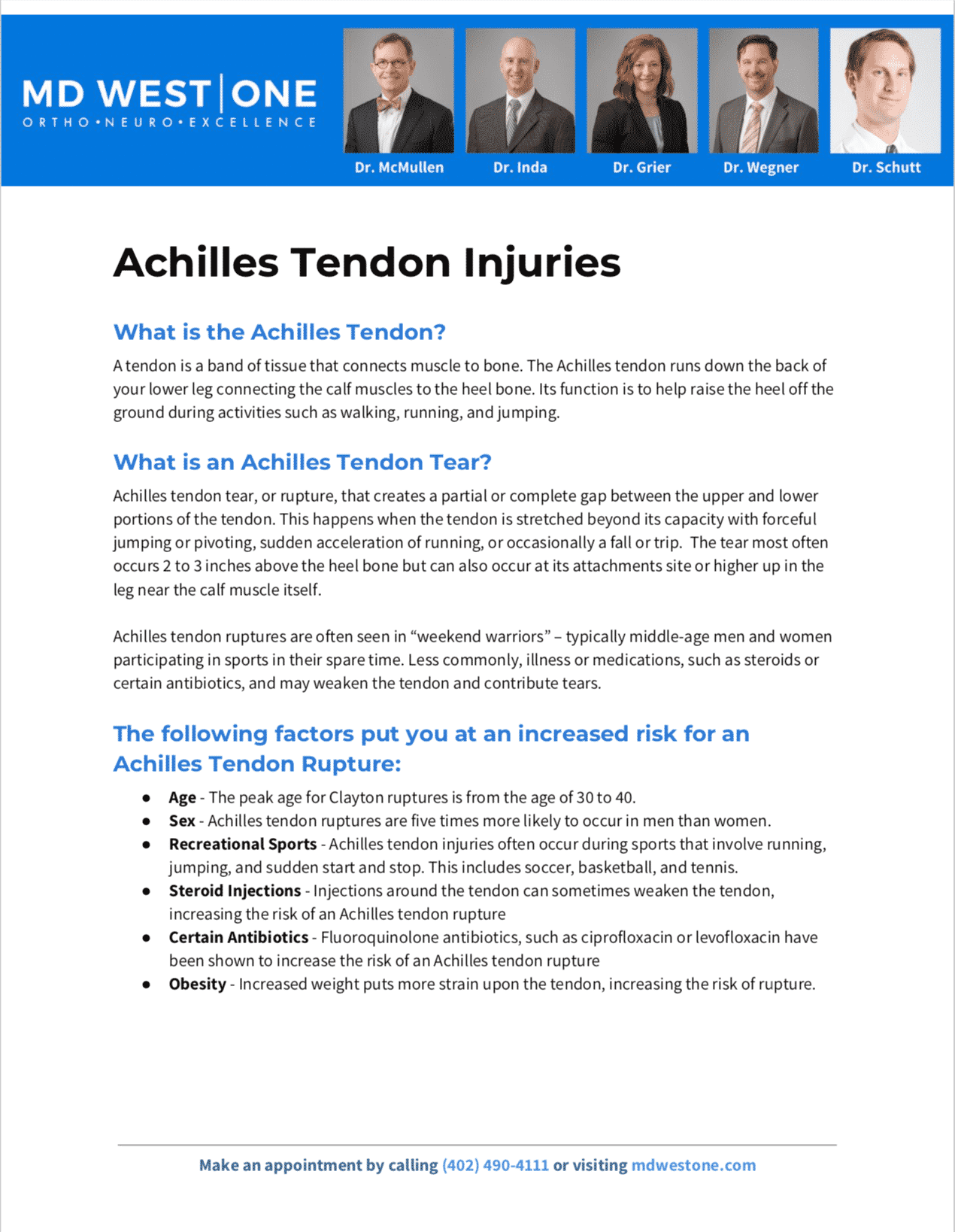Are you suffering from potential Fractures and Trauma?
The Omaha Foot & Ankle Specialists at MD West ONE are able to properly diagnose and treat fractures & trauma through both surgical and non-surgical treatments. If you have the following symptoms, you may want to make an appointment with one of our Board Certified Specialists.
- Sudden, severe pain
- Cannot put weight on your foot or ankle
- Hurts when touched
- Bruised
- Swollen
Meet MD West ONE's foot and ankle specialists and learn more about how they treat fractures & traumas.
Fracture & Trauma Causes, Treatments & Surgery
What are Fractures & Traumas?
Your joint consists of your tibia, your fibula, and your talus. Your tibia is the big bone in your lower leg and is sometimes called your shinbone. Your fibula is a smaller, thinner bone in your lower leg. The lower ends of your fibula and tibia come together and butt up against your talus. Your talus is the main link between your leg and your foot.
You can break one or more joint bones at the same time. The more bones you break, the more serious the injury. Serious fractures require surgery. It can take several weeks to two years to fully recover from a broken foot or ankle.
The following factors put you at an increased risk for Fractures & Traumas:
-
Being in a motor vehicle accident.
-
Playing sports, particularly sports where you are likely to be hit on your foot or ankle or you make sudden moves that twist your foot or ankle.
-
Falling from a significant height.
-
Tripping and falling.
-
Taking a misstep and “rolling" your ankle.
Ways to Decrease Your Risk of Developing Fractures & Traumas:
Many fractures happen after traumatic events such as motor vehicle accidents, falling, or being injured playing sports.
But you can fracture your foot or ankle simply by taking a misstep while walking, stepping off a curb, or stumbling over something in your home. You can limit this kind of risk by:
- Taking extra care when walking on uneven surfaces and curbs.
- Eliminating clutter in your home that cause you to trip over and fall.
DIAGNOSIS
Your healthcare provider has several tests they use to diagnose fractures and determine the extent of your injury. Tests your provider might use to examine your fracture can include:
- Physical examination.
- X-ray.
- Computed tomography (CT) scan.
- Magnetic resonance imagery (MRI).
- Bone scan.
NON-SURGICAL TREATMENT OPTIONS
Fracture treatment depends on factors such as the number of bones broken. Not all broken feet and ankles require surgery, but all broken ankles require some level of care to heal.
You probably will not need surgery if you have a stress fracture. You might need a brace or cast to support your foot or ankle while it heals. More serious foot or ankle fractures require reduction or surgery.
Reduction is when healthcare providers manipulate your foot or ankle to line up the ends of your broken bones. You will receive local anesthesia to numb your foot or ankle.
SURGICAL TREATMENT OPTIONS
Foot or ankle fractures are treated with surgery called open reduction internal fixation (ORIF). In ORIF, surgeons open up your injured foor or ankle and line up the ends of your broken bones. They might also install metal plates, wires, or screws to keep your foot or ankle bones stable while the bones heal.
You will receive general anesthesia. To prepare for general anesthesia, you should:
- Avoid food and drinks for eight hours before you go to the hospital unless directed.
- If you smoke, quit smoking at least two weeks before your surgery to improve your heart and lung health. Even quitting for one day before your surgery helps your heart and lungs.
- Stop taking herbal supplements and anti-inflammatory drugs for one to two weeks before the procedure as directed by your healthcare provider.
- Stop taking Viagra® or other medications for erectile dysfunction for at least 24 hours before the procedure.
- If you take certain (but not all) blood pressure medications, talk to your healthcare provider about taking your medication with a sip of water.
What happens during ORIF surgery?
- Your surgeon makes incisions to open your joint to access your broken bones.
- They line up your broken pieces. This is called reduction.
- Your surgeon uses tools such as metal plates, screws, or wires to connect your broken pieces. This is called internal fixation.
- They close the incision.
- Your surgeon will put your ankle in a cast or brace.
POST-OPERATIVE RECOVERY
Fractures can take a long time to heal. Recovery depends on how much damage was done when you fractured your foot or ankle. Most people can put weight on their foot or ankle within 16 weeks after surgery. But it can take as long as two years for a foot or ankle fracture to heal completely.
Frequently Asked Questions?
What follow-up appointments will I need after my surgery?
Here are typical post-surgery follow up appointments:
- Your surgeon will see you a week after surgery to take X-rays to confirm your bones are healing appropriately.
- They will remove your cast about six weeks after your surgery.
- Your surgeon might recommend additional surgery to remove the metal pieces that supported your foot or ankle while it was healing.
- They might recommend physical therapy to strengthen your ligaments.
You should contact your healthcare provider or go to the emergency room if you have:
- Uncontrolled pain.
- Numbness.
- Tingling
- Increased swelling
- Any change in your ability to put weight on your injured foot or ankle.
- Signs of infection such as fever, chills, redness, or your incision is draining.
- Re-injured your foot ankle.
What questions should I ask my doctor?
- What kind of fracture do I have?
- Do I have to have surgery?
- Will I need to wear a cast or a brace?
- Will I need to have physical therapy?
- How soon can I put weight on my injured foot or ankle?
- When can I play sports?
- How long before my foot or ankle is completely healed?
AMERICAN ORTHOPAEDIC FOOT & ANKLE SOCIETY
All of the foot and ankle surgeons in the practice are recognized members of the American Orthopaedic Foot & Ankle Society. It is the oldest and most prestigious medical society dedicated to the foot and ankle. The mission of the society is to advance science and practice of foot and ankle surgery through education, research, and advocacy on behalf of patients and practitioners. These physicians dedicate their time and energy to improving the patient experience and their knowledge in their field. For more information visit http://www.aofas.org.
MD West ONE Foot & Ankle Specialists:
The Foot & Ankle Specialists are all Board Certified and Fellowship-Trained, meaning they’ve focused their education, training and research on orthopaedic surgery of the foot and ankle.





